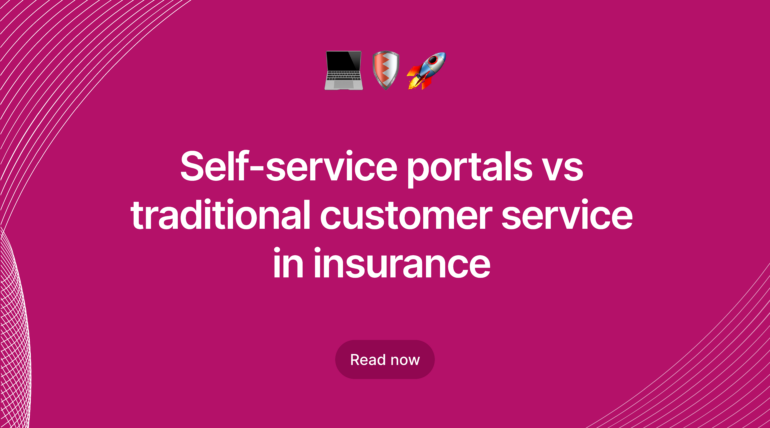
According to a recent survey, 72% of customers are more likely to recommend a business based on their customer experience with a service or a product. On the other hand, 13% of the customers will always take advantage of a chance to share their negative customer experience with their kith and kin.
This stat is more than enough to discuss the impact of customer experience in a business, regardless of whether you are selling an insurance policy or a pack of candies. When the concern is selling insurance policies, customer experience is everything. One cannot achieve it only by deploying tons of employees to provide support, calls, e-mail, and chat. It is important to cut through the noise and try to decode the key problem customers are facing and how it can be improved.
In this blog, we will discuss self-service portals vs traditional customer service and how modern technologies can pave the way for a new era of customer experience in the insurance industry.
How does the insurance self-service portals improve customer experience?
Self-service portals provide customers with online platforms where they can easily access policy information, make changes, and file claims without contacting customer service representatives directly. This accessibility allows customers to view policy details, coverage limits, and deductibles anytime, leading to higher satisfaction as they can quickly find what they need without waiting. Moreover, customers can upload photos of damages and provide incident details, speeding up the claims process and reducing stress. Additionally, these portals offer tools and resources like informative videos and online calculators to help customers manage their insurance needs more effectively.

Understanding insurance self-service portals
Insurance self-service portals streamline policy management for customers, providing easy access to details, payments, and claims without direct contact with providers. These portals reduce providers’ administrative burdens while enhancing customer satisfaction.
Self-service portals offer 24/7 access to policy details, improving satisfaction by eliminating wait times for customer service assistance. Customers can quickly and easily make policy changes themselves, saving time and frustration. A streamlined claims process through self-service portals reduces stress and speeds up claim resolution.
Benefits of self-service portals for customers
- 24/7 access to policy details improves satisfaction by eliminating wait times
- Easy policy modifications save time and frustration for customers
- Streamlined claims processes simplify filing and speed up resolution
Benefits of self-service portals for providers
- Reduced administrative burdens and enhanced customer satisfaction
- Secure, user-friendly portals enable easy access to policy details.
- Overall, self-service portals streamline policy management for both customers and providers, enhancing satisfaction and reducing administrative burdens.
Self-service portals for insurance vs Traditional customer service: A detailed comparsion
| Aspects | Self-service portals | Traditional-customer service |
| Accessibility | 24/7 available for support | Restricted to business hours |
| Response time | Instant customer support | A few hours to days depending on business |
| Communication channels | Omni-channel engagement with customers | Phone, e-mail, or in-person |
| Personalization | Personalized & contextual | Generic & template-based responses |
Benefits of self-service portals for insurance companies

Enhanced customer experience
Efficient digital self-service platforms offer customers a quicker and more convenient experience. They can access policies, make changes, and file claims anytime, anywhere, eliminating the need for physical visits or waiting on hold. In today’s digital age, customers appreciate this independence, making it an attractive feature for both retaining existing customers and attracting new ones.
Improvised efficiency & cost savings
Digital self-service platforms streamline operations by empowering customers and automating routine tasks. This reduces the need for manual intervention, leading to increased operational efficiency, decreased labor costs, and lower administrative overhead. With resources allocated more effectively, employees can focus on value-added tasks that require human insight and expertise.
Speedy claim processing
Filing claims is a critical interaction between customers and insurers. Digital self-service platforms enable customers to instantly file and track claims, expediting processing and resulting in faster settlements and higher satisfaction. This enhances customer relationships, potentially extending their tenure and opening doors to upselling opportunities.
Data-driven decision making
Self-service platforms collect valuable data on customer preferences, behaviors, and needs. This data can inform trend analysis, risk assessment, and the creation of personalized products and services. By leveraging this information, insurers can make more informed decisions and offer targeted, strategic, and appealing solutions to their customers.
Conclusion
In conclusion, the adoption of digital self-service platforms in the insurance industry represents a significant step towards enhancing customer experiences, improving operational efficiency, and driving strategic decision-making. By offering customers greater convenience, streamlining processes, and leveraging data insights, insurers can strengthen relationships, reduce costs, and remain competitive in an increasingly digital landscape.
Exploring these technologies meets the evolving expectations of today’s consumers, positioning insurers for long-term success in a rapidly changing market. As we move forward, continued investment in digital innovation will be paramount to staying ahead of the curve and delivering value to customers and stakeholders alike.







